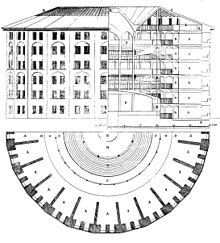Willey Reveley
This article needs additional citations for verification. (June 2013) |
Willey Reveley (1760–1799) was an 18th-century English
Around 1788, Reveley travelled in Greece to make sketches for Sir Richard Worsley.[3] That year, he married Maria James, better known under her later married name of Gisborne as a friend of Mary and Percy Bysshe Shelley. Maria's father opposed the marriage and refused to help the couple financially. They returned to England, where they lived on an income of £140 a year. Their son, Henry Willey Reveley (1788–1875), became a civil engineer and architect in Cape Town and Western Australia.[4][5] Their other son's name is unknown.

Reveley was a strong liberal and became a friend of William Godwin and Thomas Holcroft. About 1791 he received his first professional fee as an architect, £10, for assisting philosopher Jeremy Bentham in preparing architectural drawings for Bentham's scheme for a Panopticon prison.[4] Reveley continued to work on the project with Bentham for the rest of the 1790s.
Reveley contributed some views of the

In 1796, Reveley made four proposals to straighten the
Like the Thames scheme and the Panopticon prison, Reveley's designs for a public bath complex at Bath and an infirmary at Canterbury did not come to fruition.[6][9] His completed projects were All Saints' Church, Southampton (constructed 1792–1795, destroyed in 1940);[6] and Windmill Hill, Sussex, a country house built for W. H. Pigou and completed in 1798.
He died on 6 July 1799 "[a]fter a few hours illness".[6]
References
- doi:10.1093/ref:odnb/23393. (Subscription or UK public library membershiprequired.)
- JSTOR 147240.
- doi:10.1093/ref:odnb/10780. (Subscription or UK public library membershiprequired.)
- ^ ISBN 978-071905610-9.
For example, Henry Willey Reveley – Jewell's predecessor as the colony's architect – was the son of Willey Reveley who had worked directly with Jeremy Bentham in designing and drawing a number of his architectural propositions such as the 'Penitentiary Panopticon' illustrations of 1791.
- JSTOR 435236.
- ^ a b c d e Nichols, John (1815). "Obituary of Mr. Willey Reveley". The Gentleman's Magazine. Vol. 86. p. 627. Retrieved 29 September 2015.
- ^ Forrow, Alexander (1877). The Thames and Its Docks: A Lecture. Spottiswoode. pp. 41–42. Retrieved 29 September 2015 – via Internet Archive.
- ISBN 978-072300342-7.
- ^ "Willey Reveley and the Bath Pump Room". The Architect: 118. 23 February 1878.
